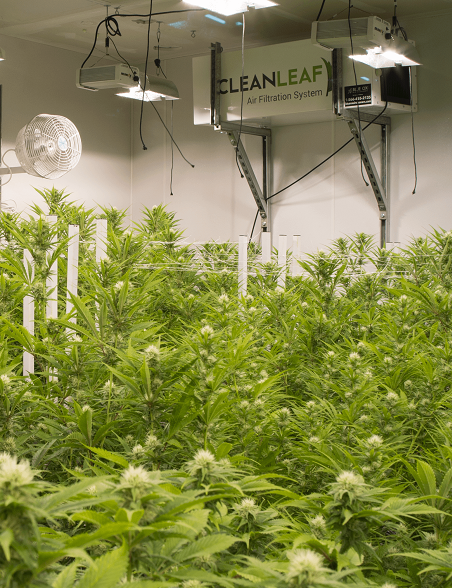The regulations that surround cannabis are known to range widely based on the jurisdiction, including when it comes to cannabis microbes. Cannabis regulations are subject to change, and new laws are regularly introduced and implemented to protect consumers. Microbial contamination in cannabis products poses substantial health risks, especially for immunocompromised individuals. To enhance consumer safety, some states have implemented rigorous regulations, some including microbial testing requirements.
As we explore cannabis microbes regulations, we will cover the intricacies of cannabis microbial regulations, shed light on the testing challenges faced by the industry, and illuminate the pivotal role of grow room air filtration systems in fostering a pristine cultivation environment.
Cannabis microbes can consist of various microorganisms such as bacteria like Aspergillus, salmonella, and Escherichia coli that can result in safety and health risks when consumed. According to the National Institutes of Health, "among 40 Aspergillus species, only four —A. fumigatus, A. flavus, A. niger, and A. terreus—have been singled out to date for testing on cannabis due to their association with the plant and potential health effects."

State-certified labs typically use a technique called gas chromatography to determine residual solvents, however, states do not agree on which microbial contaminants to test for in the first place or which constitute a health risk. Even though pathogenic Aspergillus spores may be able to survive the heat of combustion, some states consider the risk of harm to be low enough that certain states such as Oregon and Massachusetts do not require any specific tests for Aspergillus, while California regulators take it very seriously.
Frontiers conducted an investigation into microorganisms in cannabis post-heating in a commercial vaporizer. The study aimed to determine whether the heating of cannabis, following the temperature and time parameters set by a commercial vaporizer used in clinical settings, would significantly reduce microbial loads in cannabis plant material. To address this inquiry, bulk cannabis plant material provided by the National Institute on Drug Abuse (NIDA) was utilized to assess the impact of heating through a commercial vaporizer. The findings of the study revealed that "there were trends of reductions in microbial counts with heating; however, these reductions were not statistically significant. This suggests that heating under standard vaporization parameters (70 seconds at 190°C) may not eliminate the existing microbial bioburden, including any opportunistic pathogens. Subsequent DNA sequence analyses identified several fungal and bacterial taxa in the different products, associated with opportunistic infections or allergic reactions" (Frontiers, January 13, 2023).
Other regulatory standards may include:
Acceptable Limits: Regulations establish acceptable limits for microbial contaminants. Products that exceed these limits may be deemed unsafe for consumption and may be subject to disposal or remediation.
Good Manufacturing Practices (GMP): Regulations may outline good manufacturing practices that cannabis cultivators and processors must adhere to. These practices are designed to ensure the overall safety and quality of cannabis products.
Reporting and Recordkeeping: Cultivators and manufacturers may be required to keep detailed records of their cultivation and processing practices, including microbial testing results. These records may need to be made available for regulatory inspections.
Remediation Protocols: In some cases, regulations may specify procedures for remediating cannabis products that exceed microbial contamination limits. Remediation may involve processes to reduce or eliminate contaminants.
Grow room air filtration systems play a crucial role in preventing microbial contamination at the cultivation, drying, curing, and packaging stages. These systems help maintain a clean and controlled environment by filtering out airborne contaminants, including bacteria and mold spores. By investing in effective air filtration, cultivators can proactively address microbial concerns and contribute to the overall safety of their cannabis products.
CleanLeaf is a leader in the cannabis cultivation industry, specializing in air filtration systems tailored to the unique needs of growers. The CleanLeaf line includes four models with various configurations to help cultivators protect crops from microbes, mold, and other contaminants to protect the quality and integrity of cannabis products.
The CleanLeaf Clean Room Series is an excellent option for preventing microbial contamination. These units come equipped with a powerful 1000-2000 CFM blower. Air is forced through the 99.99% efficient, high-capacity V-Bank HEPA filter to eliminate airborne threats and provide plants with medical-grade clean air.
It's essential to check the most recent and specific regulations for your location. PathogenDx keeps an updated list so that you can find out exactly what the state your Cannabis lab, grow or processing operation does business in requires and regulates. For more information about cannabis microbes regulations in your jurisdiction, or to learn more about how CleanLeaf grow room air filtration systems can help you meet regulatory standards, contact us.
You may also like:
• How Does CleanLeaf Work?
• Grow Room Air Filtration Systems vs Air Purifiers
• Troubleshooting Air Quality Issues in Grow Rooms